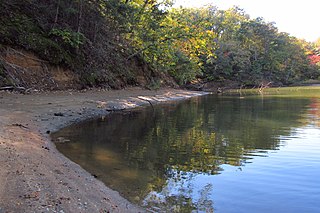Related Research Articles

The Buckingham House and Industrial School Complex is a historic trade school complex located near Buckeystown, Frederick County, Maryland. It consists of thirteen buildings associated with a trade school for boys from poor families that operated from 1898 to 1944. The complex centers on a 3-story dormitory building built for the school, but also includes the late 18th-century Federal style Buckingham House. The surrounding farm was, uniquely for the area, irrigated. Bordering the Monocacy River, the grounds include several significant late Woodland period archeological sites.

The National Archives Site is an archeological site at the National Archives facility in College Park, Prince George's County, Maryland. The site contains archeological remains from prehistoric settlements during the Late Archaic period, c. 4000-1500 B.C. Stone artifacts recovered through archeological testing indicate that this camp served as a place of stone tool manufacture and probably as a staging point for hunting and foraging. Physical integrity of the prehistoric component is high, with little plow disturbance or admixture with artifacts from other periods. The presence of a small number of other artifacts, including the projectile points, a spokeshave, and utilized flakes, indicates that the site also served in other hunting and foraging pursuits. It is one of a relatively small percentage of known prehistoric properties in Maryland with undisturbed archeological deposits.

The Avondale Mill was a large gable-front stone structure, three stories in height, and 10 bays long by three wide. It was located on the bank of the Patuxent River in the city of Laurel, Prince George's County, Maryland. It was constructed in 1844-1845 for Captain William Mason & Son of Baltimore. It was complemented by the neighboring Laurel Mill built in 1811 S.D. Heath's machine shop and Richard Israel's flouring mill. At that time it was provided with the machinery for the manufacture of fine cloth, running as many as 1,500 cotton spindles with 150 employees. In 1845, industrialist Peter Gorman was responsible for the first macadamized (paved) road in Laurel, Avondale Street next to the new Mill.
Nottingham is a small town on the Patuxent River in Prince George's County, Maryland, United States. It contains an archaeological site which was listed on the National Register of Historic Places in 1975.
Aisquith Farm E Archeological Site is an archaeological site near Riva in Anne Arundel County, Maryland. It is one of several small sites located within the confines of Aisquith farm. It is associated with the Early and Middle Woodland periods of cultural development in Anne Arundel County. The site is significant as a base camp property type.
Arundel Cove Archaeological Site is an archaeological site near Baltimore in Anne Arundel County, Maryland. It is situated on the south shore of Arundel Cove, a tributary of Curtis Creek which drains into the Patapsco River. The site was discovered during routine shovel test pitting of the U.S. Coast Guard Yard at Curtis Bay in 1981. The test pits revealed that the site is small in size, extending only 20 feet north–south by 15 feet east–west. It represents the remains of a prehistoric summer camp which apparently was not repeatedly occupied. It contains a prehistoric period storage pits, with evidence of the use of galium and wild black cherry.
The Katcef Archeological Site is an archaeological site near Crofton in Anne Arundel County, Maryland. It is a series of overlapping base camp sites dating from the Clovis phase of the Paleoindian period, through to the Late Woodland period. The primary era of site utilization was during the Late Archaic period.
The Magothy Quartzite Quarry Archeological Site is an archaeological site near Pasadena in Anne Arundel County, Maryland. The site consists of several large outcroppings of quartzite and sandstone, that may have been utilized by prehistoric Native American groups as early as the Middle Archaic period, if not earlier.

The Martins Pond Archeological Site is an archaeological site near Annapolis in Anne Arundel County, Maryland. It is a Middle-Late Woodland period site, with lithic, floral, and faunal remains.
The Shawnee Old Fields Village Site, is an archaeological site near Oldtown in Allegany County, Maryland. The site contains Late Woodland and Contact period artifacts. An area between the site and the river's edge may be the location of a number of short-term camps and/or dwelling units. The first confirmed archeological manifestation of the several historically documented Shawnee villages in Maryland. It is believed to have been the home of Chief Opessa Straight Tail, a Shawnee leader.
Buckingham Archeological Site is an archaeological site near Berlin in Worcester County, Maryland. It is one of the few known Woodland period village sites in the coastal marsh areas of the Atlantic Coast section of Maryland. The site falls within the general vicinity of an Assateague Indian town. It is located four miles east of the Sandy Point Site, both including the southernmost reported occurrence of Townsend Series ceramics on the coastal section of the Eastern Shore.
The Sandy Point Site, or Sandy Point Archeological Site, is an archaeological site near Ocean City in Worcester County, Maryland. It contains the southernmost component of the Townsend Series on the Delmarva Peninsula. It is also one of the few known Woodland period village sites in this area. These traits are shared by the nearby Buckingham Archeological Site.
Willin Village Archeological Site is an archaeological site near Eldorado in Dorchester County, Maryland. The Sussex Society of Archeology and History extensively excavated this site between 1951 and 1953. They identified grooved axes and stemmed points indicating use by Archaic peoples. It was possibly the site of a village during the Late Woodland period.

St. Francis Xavier Church, or Old Bohemia, is a historic Roman Catholic church located at Warwick, Cecil County, Maryland, United States. It is located on what was once the Jesuit estate known as Bohemia Manor.
The Bumpstead Archeological Site is an archeological site located near Elkton, Cecil County, Maryland. The site is one of a group of interrelated sites illustrating the various phases of stone tool production and living area activities.
The Heath Farm Jasper Quarry Archeological Site is an archeological site located near Elkton, Cecil County, Maryland. The site is one of a group of interrelated sites illustrating the various phases of stone tool production and living area activities.
The Iron Hill Cut Jasper Quarry Archeological Site is an archeological site located near Elkton, Cecil County, Maryland, United States. The site is one of a group of interrelated sites illustrating the various phases of stone tool production and living area activities.
The McCandless Archeological Site is an archeological site located near Elkton, Cecil County, Maryland. The site is one of a group of interrelated sites illustrating the various phases of stone tool production and living area activities.
The Grear Prehistoric Village Site is an archeological site located near Crystal Beach, Cecil County, Maryland. The site was discovered and tested by an amateur archeologist in 1971. It is the northernmost known Late Woodland period village site on the Eastern Shore of the Chesapeake Bay outside of the Susquehanna River Basin.
The Snow Hill Site is an archeological site located near Port Deposit, Cecil County, Maryland. It was the location of a free African American community, which was established in this area by the mid-19th century. It includes the remains of several structures, a foundation and wall or floorboard, two in situ cast iron stoves, and concentrations of refuse. Only the portion of the site located on the United States Naval Training Center Bainbridge property has been tested. The only remaining standing structure from the community is a two-story, two-family duplex built in the late 19th century, which is located nearby.
References
- 1 2 "National Register Information System". National Register of Historic Places . National Park Service. July 9, 2010.
- ↑ "Heath Farm Camp Archeological Site". Maryland Historical Trust. Retrieved October 29, 2008.

